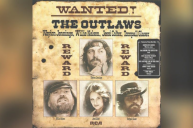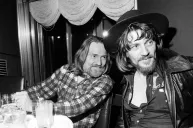Like the imposing chimes of a grandfather clock, the six opening chords of Willie Nelson's landmark Red Headed Stranger signaled a new hour for music. A dark, rambling, bare-bones tale about a man's jealous rage and his path to self-forgiveness, it cemented Nelson's legacy as one of country music's most celebrated storytellers. It proved that concept records were not exclusively rock's domain. 40 years later, we look back at the impact of the complex album and its unlikely success.
Home On The Ranch
First, some backstory. Nelson grew up on the plains of Depression-era Texas, and after his parents split, he and sister Bobbie were raised by their grandparents. At the age of six, he was given a guitar, and he never looked back. Many of his music's enduring influences can be traced back to his surprisingly diverse hometown of Abbot.
His Mexican neighbors gifted him with a lasting appreciation for music from south of the border. Having Czechoslovakian neighbors meant constant exposure to waltzing and polka dancing, whose hobbling downbeats are still crucial to modern country. And going to church every Sunday meant plenty of gospel got stuck in the young man's head.
Given The Boot
In 1973, Willie Nelson was beginning to make a name for himself in Nashville. He had just signed a $25,000 contract with Atlantic's country branch in Music City ($133,000 in today's money). He had released two successful records with them, Shotgun Willie and Phases and Stages (another concept record, about divorce).
SEE ALSO: 5 Badass Stories About Outlaw Country Artists
But Atlantic decided to shutter its country experiment, which left Nelson without a label. His savvy manager Neil Reshen phoned up Columbia's president Bruce Lundvall and negotiated a contract, but one that included a clause giving Nelson complete artistic control. This would prove to be a music biz anomaly and Red Headed Stranger's saving grace.
Leaving Nashville turned out to be a blessing in disguise. There, the expectation was to be clean-cut in countenance and studio. The album sounds the way it does in part, thanks to Nelson's relocation to Austin. Its burgeoning hippie movement, which is still going strong today, made Willie feel like a misfit who found a home with other misfits. No longer having to worry about image, Nelson was free to focus solely on his sound.
For The Record
Nelson used to DJ a Fort Worth kids' radio show from 1-1:30 pm every day. It broadcasted tunes to exhausted parents who desperately wanted their children to nap for thirty minutes. Nelson obliged them with songs like "Tale of the Red Headed Stranger" and Tex Ritter's "Blood on the Saddle," songs which might not be considered appropriate children's music these days.
Years later, having been handed the reigns by CBS, Nelson's then-wife (his third) Connie Koepke inspired him to take the original Red Headed Stranger and flesh it out, turning it into an aural western novel. Engineer Phil York lured Nelson to Autumn Sound Studio in Garland, Texas, and they set to work. Any instrumentation favored by the glossy hot country of the day was stripped away, leaving Nelson's plucky acoustic guitar Trigger, upright bass, drums, piano (played by his sister and frequent collaborator Bobbie), and occasional accordion, mandolin, and harmonica. The sessions didn't take long. Harp player Mickey Raphael said part of the reason the concept album is so sparse is that it was recorded live - there were very few do-overs. Bassist Bobby Earl Smith even claims that their version of "Blue Eyes" was a one-take recorded with everyone sitting in a circle. Like an intimate house show, the songs are spare but expansive, and perfectly mic'd.
Folk Tale
The songs - vignettes, really - are mostly only at or under two minutes. They ingeniously alternate between the Stranger's first-person travels and an omnipresent third-person narration, giving his voyage a fated feel, as if the Stranger is being watched from above with great care.
After the first "Time of the Preacher," a refrain repeated and modified throughout side one, the story begins. The Stranger loves his wife dearly but thinks she's cheating on him; his suspicions are confirmed when, one day, he comes home to an empty house. He's beyond distraught, and he cries, "like a panther in the middle of the night." He tries to forgive and forget, but the vacant hallways haunt him, and his loneliness turns into a singular, coldblooded thirst for revenge. In "Blue Rock Montana," he finds his ex and her new beau in a bar and shoots them so quickly, "they died with their smiles on their faces."
It is precisely then that The Stranger becomes the Red Headed Stranger. He aimlessly wanders from town to town in a fog of self-loathing, riding a black stallion and toting behind him the pony formerly used by his wife. When a drunk woman pets the horse, he thinks she's trying to steal it and shoots her straightaway. He once again escapes Johnny Law, the logic being: "You can't hang a man for killing a woman / Who's trying to steal your horse." (Show of hands: who else is glad the Wild West is no longer a thing?)
If a picture is worth a thousand words, then so is the title of a lyric-less song, especially in the case of the elegant waltz "Just As I Am." It ends side one but initiates the Stranger's real quest for starting anew. Side two begins with our antihero meeting his new love in Denver; like the American Dream, he must move west to find his true self. The second half of the record is noticeably jollier, with songs like "Down Yonder," giving Benny Hill a run for his money.
No Stranger To Success
Nothing about this record yodels 'commercial smash.' It flew in the face of current country practices, and many CBS execs fought not to put it out, claiming it sounded like a half-baked demo that no one would buy. "They thought I'd gone insane because there wasn't that much there," says Nelson of the now infamous board meetings. "I think Waylon Jennings shamed them into putting it out." Since his contract stipulated complete creative control, no changes were made to the tapes, and the collection more than surpassed expectations.
READ MORE: This Tiny Texas Town is a Must-See for Bob Wills Fans
Ray Benson, who was working as a session guitarist in Nashville at the time, recalls colleagues getting angry and jealous at the album's success, believing it was practically blasphemous and insubordinate to record country in so sparing a manner. But it did the trick. The Columbia Records release reached No. 1 on Billboard's Top Country Albums chart and remained in the charts for 43 weeks. Its first single, "Blue Eyes Crying in the Rain," won a Grammy for Best Male Country Vocal Performance. Less than a year later, it was certified gold; 10 years from then, it was certified double platinum. It has also become a part of the National Recording Registry.
Legacy
Rolling Stone has called it one of the top 500 greatest albums of all time, but CMT one-upped them and called it the best album of all time. CMT has appropriately deemed it "the Sgt. Peppers of country music." The album's uncommonly lucrative no-frills attitude isn't just for show - it's just how Willie is. He remains humble despite his accomplishments. "I first saw him play in Wichita Falls sometime in the 1970s," recalls outlaw disciple James McMurtry. "I was just fifteen or sixteen. And when he came out on stage, there was no big announcement. He just snuck out from behind one of the speaker columns and started playing. I learned from that. That's the way I come out on stage today."
At the time of the record's release, Nelson was on his third wife and fifth child; he had the same blue eyes and long red hair of his protagonist. Red Headed Stranger gave Nelson both an enduring nickname, and the crown jewel of his extraordinary discography. Its leanness has helped it float through the years, becoming an otherworldly, timeless classic.
Red Headed Stranger Track Listing:
1 ."Time of the Preacher" (Willie Nelson)
2. "I Couldn't Believe It Was True" (Eddy Arnold, Wally Fowler)
3. "Time of the Preacher Theme" (Willie Nelson)
4. "Medley: Blue Rock Montana/Red Headed Stranger" (Nelson/Carl Stutz, Edith Lindeman)
5. "Blue Eyes Crying in the Rain" (Fred Rose)
6. "Red Headed Stranger" (Carl Stutz, Edith Lindeman)
7. "Time of the Preacher Theme" (Willie Nelson)
8. "Just As I Am" (Charlotte Elliott, William B. Bradbury)
SIDE TWO:
"Denver" Willie Nelson
2. "O'er the Waves" (Juventino Rosas, arranged by Willie Nelson)
3. "Down Yonder," played by Bobbie Nelson (L. Wolfe Gilbert)
4. "Can I Sleep in Your Arms" Hank Cochran
5. "Remember Me" Scotty Wiseman
6. "Hands on the Wheel" Bill Callery
7. "Bandera"





